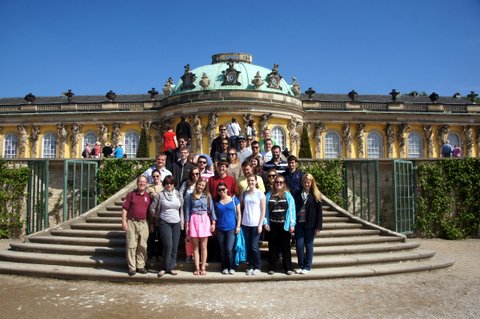
A carefree day at Sans Souci, (which means carefree)
Frederick the Great, King of Prussia (1740-1786) met the other Frederick today (me) and only one of us is still standing.
Fortunately, it’s me.
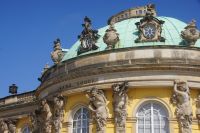
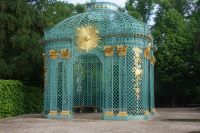 The encounter was at Sans Souci park in Potsdam, the summer home of the Hohenzollern family, which transformed Prussia from a minor principality in Northeast Europe to the feared Huns of World War I. The Hohenzollern family became king of Prussia in 1701, and lasted until the defeat of Germany in World War I. Prominent in the transformation was Frederick the Great, under whose rule the Prussian military waged war against much of the rest of Europe, and Frederick emerged as the equal of his contemporaries—Maria Theresa of Austria and that German princess turned Czarina, Catherine the Great.
The encounter was at Sans Souci park in Potsdam, the summer home of the Hohenzollern family, which transformed Prussia from a minor principality in Northeast Europe to the feared Huns of World War I. The Hohenzollern family became king of Prussia in 1701, and lasted until the defeat of Germany in World War I. Prominent in the transformation was Frederick the Great, under whose rule the Prussian military waged war against much of the rest of Europe, and Frederick emerged as the equal of his contemporaries—Maria Theresa of Austria and that German princess turned Czarina, Catherine the Great.
Usually adored by the philosophes in France, Frederick cultivated a court with musicians and artists (he composed flute and other concerti; I purchased an album), and the two castles we spent some time at today have ample concert halls, theaters (he wrote a play, too), and “writing closets” that are 3X the size of my office with Schinkler cabinets and desks that  probably are literally priceless, and silk-damask furniture that would cost roughly 1 million Euros to replace. Frederick’s influence on the architecture—a florid and showy style called rococo—gave rise to Frederich rococo,
probably are literally priceless, and silk-damask furniture that would cost roughly 1 million Euros to replace. Frederick’s influence on the architecture—a florid and showy style called rococo—gave rise to Frederich rococo,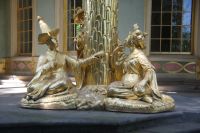 since he persisted in the style long after it had gone out of fashion. Though he cultivated the intellectuals, Frederick preferred his uniform to civilian clothes, and called his uniform his “death gown.”
since he persisted in the style long after it had gone out of fashion. Though he cultivated the intellectuals, Frederick preferred his uniform to civilian clothes, and called his uniform his “death gown.”
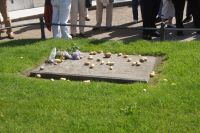
The Sans Souci palace was a “pleasure palace” built early in his reign to mimic a similar toy the much wealthier Louis XIV built at Versailles (the Grand Trianon, where the treaty was signed disposing of the Austrian Empire in World War I). It is much more complete than the other palace we saw, despite Kaiser Wilhelm having taken 59 wagon loads of family loot to the Netherlands when he abdicated in 1918, and the Soviets (Potsdam having been in East Germany) having done much the same in 1945. The palace allows only 2,000 visitors a day, and we had a guide and the place pretty much to our own—a treat after the zoo at Versailles. Frederick built the vineyards first (I told you it was a pleasure palace), and gave prominence to his quarters and those of his guests; his loveless marriage meant his wife had her own palace elsewhere, and I think we were told she set foot in Sans Souci once. One other item the guide discussed fit in well in the theme of our European Union explorations: she discussed the cost of bringing goods into Prussia, the tariffs on them, and the eventual creation of domestic industries in Prussia to produce porcelain (replacing Messian) and silk.
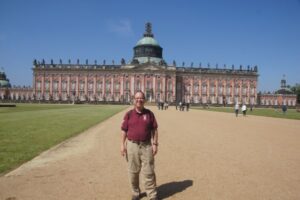
The other palace, the “New Palace,” was built after the 7 years war (as Europeans call the French and Indian War), which marked Prussia’s entrance as a great power. As I recall, one other manifestation of that was its participation in the partition of Poland, the consequences of which reached to World War II, with the massive resettlement of Germans and Poles as the borders of the Soviet Union moved farther West. The building is mostly stripped of its 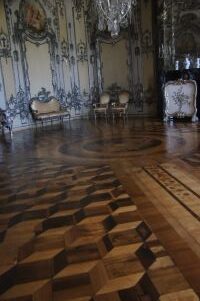 interior decorations—by Kaiser Wilhelm and the Soviets–but the sumptuous rooms and floors remain. We had to put on kind of an overshoe to walk on the floors, and we were not permitted in several rooms which could not stand the traffic. One room had three or four huge mythological paintings with a lot of nudes. The guide told us that they were originally painted for the court of Austria, but Empress Maria Theresa, scandalized, ordered them sold. The fervently anti-Austrian (part of it was
interior decorations—by Kaiser Wilhelm and the Soviets–but the sumptuous rooms and floors remain. We had to put on kind of an overshoe to walk on the floors, and we were not permitted in several rooms which could not stand the traffic. One room had three or four huge mythological paintings with a lot of nudes. The guide told us that they were originally painted for the court of Austria, but Empress Maria Theresa, scandalized, ordered them sold. The fervently anti-Austrian (part of it was 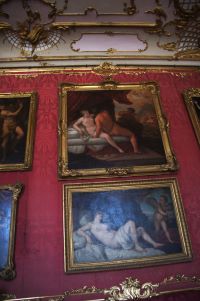 Protestant Prussia and Catholic Austria) Frederick bought them and installed them in his palace. The other item of interest was that Kaiser Wilhelm of World War I fame, moved his family permanently to the “New Palace” (it had been the summer palace, with the main quarters elsewhere in Berlin or Potsdam) and modernized it with toilets and electricity. It was in this palace on August 1, 1914 that he signed the order to mobilize the German army, a decision that ultimately triggered the First (and the Second) World Wars.
Protestant Prussia and Catholic Austria) Frederick bought them and installed them in his palace. The other item of interest was that Kaiser Wilhelm of World War I fame, moved his family permanently to the “New Palace” (it had been the summer palace, with the main quarters elsewhere in Berlin or Potsdam) and modernized it with toilets and electricity. It was in this palace on August 1, 1914 that he signed the order to mobilize the German army, a decision that ultimately triggered the First (and the Second) World Wars.
It was fitting that we had our first pleasant weather of the trip, probably in the 70s, with no rain and little wind. We were literally Sans Souci.